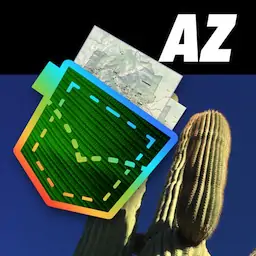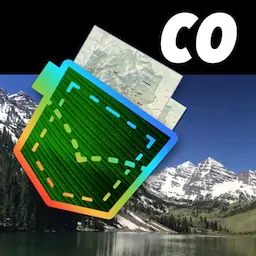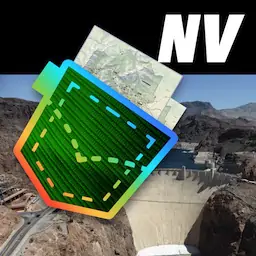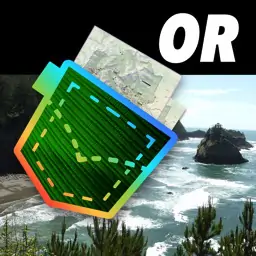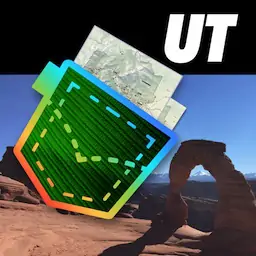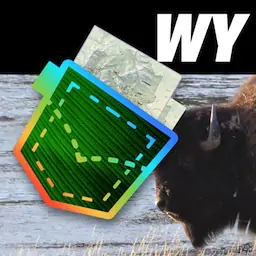Emigrant TrailsCalifornia NHT |
Brochure about Emigrant Trails of Northeast California. Published by the Bureau of Land Management (BLM).
featured in
| National Parks Pocket Maps |  | |
| Arizona Pocket Maps |  | |
| California Pocket Maps |  | |
| Colorado Pocket Maps |  | |
| Idaho Pocket Maps |  | |
| Nevada Pocket Maps |  | |
| Oregon Pocket Maps |  | |
| Utah Pocket Maps |  | |
| Wyoming Pocket Maps |  |
Emigrant Trails of Northeast California
Between the 1840s and 1870s, Euro-Americans sought
opportunity and traveled throughout this area. Pioneers
emigrated from the eastern United States and were motivated
by economic incentives including gold, undeveloped lands, and
the promise of a new life.
Four major emigrant routes traversed northeastern California and northwestern Nevada within the boundary
of the Applegate Field Office. These included the Applegate Trail to Oregon, the Lassen Trail to the upper
Sacramento Valley, the Burnett Cutoff from Oregon to California, and the Yreka Trail to the Yreka mines in
Siskiyou County.
These routes, among other lesser local trails, were traveled upon by Native Americans, fur trappers of the
Hudson Bay Company and explorers such as John Frémont and Kit Carson.
Applegate Trail
and continuing on to northern Sacramento Valley in
the vicinity of present-day Chico.
The Applegate Trail was
named after the Applegate
brothers - Jesse, Lindsay
and Charles - who
pioneered the trail in 1846.
This trail diverged from
the Oregon Trail at Fort
Hall, Idaho, and traveled
through the Great Basin,
the formidable Black Rock
Desert, High Rock Canyon,
the lush Surprise Valley, and
over the Warner Mountains.
The trail was advertised as a shorter and more
efficient route than the California Trail, but in reality
it was neither. One anonymous Lassen Trail traveler
noted it was, “the rockiest road ever.”
Burnett Cut-Off
Jesse Applegate,
Courtesy of OSU
From the Warner Range it traversed the Devils Garden
north of Alturas, “where wagon wheels rarely touched
the earth,” according to travelers who faced the rocky,
volcanic terrain before continuing on to the fertile
Willamette Valley of Oregon.
Lassen Trail
In 1848, Peter Lassen, pioneered the Lassen Trail
route by leading a group of 12 wagons off of the
Applegate Trail, at the southern end of Goose Lake,
In 1848, en-route to the rich farmlands and the
California gold fields, the Peter Burnett-led party
left the Applegate Trail in the Tule Lake Basin and
joined the Lassen Trail near Lookout, California. With
Hudson Bay trapper Charles McKay as guide, they
headed south toward Big Valley near present day
Bieber.
Peter Burnett eventually became the first elected
governor of California (1849-1851).
Yreka Trail
The Yreka Trail left the Applegate at lower Klamath
Marsh and headed west to the Yreka mines and the
rich Klamath River gold country of Siskiyou County.
This trail was also a supply route during the Modoc
War and used as recently as the 1950s.
California National Historic Trail
The California National Historic Trail
passes through lands in California and
Nevada managed by the BLM Applegate
Field Office.
Designated in 1992, the California Trail System commemorates all associated trail branches that brought
settlers to this part of the American West. Today, these trails have associated auto tours, educational
programs, and visitor centers.
Visit the History of the
Modoc Plateau
To learn more about the Pit River, Modoc and Klamath tribes, visit
the local museums, read the many historical publications or visit
online to www.pitrivertribe.org, www.modocnation.com and
www.klamathtribes.org.
Lava Beds National Monument
530 667-8100
Modoc National Forest
530 233-5811
Alturas Chamber of Commerce
530 233-4434
For Emergencies call 911.
You can learn about prominent historical figures
such as Modoc Leader, Kintpuash (Captain Jack),
Pit River Chief, Istet Woiche (William Hulsey), Peter
Lassen, John Frémont, the Applegate brothers,
General George Crook, and Peter Burnett.
Wagon Ruts, Photo by Bob Black
You can learn about the tragic Modoc War and
Battle of Infernal Caverns and the experiences of early pioneers as they traveled west. Refer to the map on
the opposite side of this brochure for locations of each panel and related Trails West markers.
Leave No Trace
Dispose of Waste Properly:
The emigrants only packed what they needed. Pack
it in, pack it out. Properly dispose of all food scraps
and trash.
Respect the Rights of Others:
Be aware of private property; leave gates as you
find them, and don’t let your dogs harass wildlife or
livestock.
Respect Natural and Cultural Resources:
Driving off road is prohibited. It is illegal to damage
archaeological sites or take cultural artifacts.
Keep informed of weather and route information
just as the emigrants used guides and trail
mailboxes along the trail. Do not rely on your cell
phone, service is intermittent.
Be Informed:
Find Out More:
Klamath County Historical Museum
Modoc Historical Museum
600 S Main St, Alturas, CA 96101
(P) 530-233-2944
Fort Crook Museum
43030 Fort Crook Museum Rd,
Fall River Mills, CA 96028
(P) 530-336-5110
U.S. military forts, such as Fort Bidwell, were established to protect
settlers and emigrants. Despite changes and adversities over
generations, local tribes maintain strong ties to their respective
cultural lifeways and customs.
Lassen National Forest
530 257-2151
Modoc Historical Society 530
233-2944
Today, you can follow the footsteps of the emigrants
and explore the rich history of the area by visiting the
many interpretive panels throughout Modoc, Lassen,
Siskiyou, Shasta, and Washoe counties.
Visit these local history museums and online
resources for interpretive displays, trails west,
markers, detailed historical accounts of the
pioneers traveling west and much more:
They introduced foreign diseases that decimated indigenous
populations. Conflicts between settlers and Native Americans
increased as more emigrants traveled west, culminating in the
Modoc War of 1872-1873.
Lassen Volcanic National Park
530 595-4480
These trails fostered commerce
and encouraged the development of
transportation and settlement for tens of
1860 Trail and Exploration Map, Courtesy of CSU Chico
thousands of people.
As the emigrants discovered, preparation is key
to survival. Know your route, as many roads are
unpaved. Bring plenty of water and provisions, and
let someone know where you are going and when
you plan to return.
Long before the first emigrants came to this area, the Pit River,
Modoc, Northern Paiute, and other indigenous people called this
area home from time immemorial. These native peoples experienced
significant changes to their traditional ways of life as Euro-American
settlers traveled through, and often took by force traditionally
occupied lands.
Bureau of Land Management
Black Rock Field O ice
775 623-1500
Explorers, often traveling in the footsteps
of Native Americans, established
numerous trails to create the best
available route, or in some cases to
exploit naive emigrants.
Plan Ahead and Prepare:
Before the Trail
Bureau of Land Management
Applegate Field O ice
708 West 12th Street Alturas,
CA 96101
Phone: 530 233-4666
Trails included in this system were mid19th century highways for emigrants
enticed by promises of gold, ranching,
and rich farmlands in California and
Oregon.
The traces left by the wagons are still visible today.
The impacts we leave on this landscape can last for
hundreds of years. Here are some Leave No Trace
principles to follow as you travel the Great Basin
and the Modoc Plateau.
Black Rock Desert, BLM Photo
Contact Information
Emigrant
Trails
California National Historic Trail
Gas, supplies, and hospitals are available in
Cedarville, Alturas, and Fall River Mills. Purchase
maps at any BLM office.
1451 Main St, Klamath Falls, OR 97601
(P) 541-882-1000
Lava Beds National Monument
1 Indian Well Hqts, Tulelake , CA 96134
(P) 530-667-8113
Trails West. INC
www.emigranttrailswest.org
Oregon-California Trails Association
www.octa-trails.org
The Oregon History Project
www.oregonhistoryproject.org
Siskiyou County Historical Museum
910 S Main St, Yreka, CA 96097
(P) 530-842-3836
Map and Guide
Women of Pit River, Courtesy of CSU Chico
140
Klamath Falls
5
§
¦
¨
97
140
66
Emigrant Trails
California National Historic Trail
205
O
39
161
Dorris
B
%
,
96
140
A
$
+
Tule
Lake
e
g
o
n
¬
«
£
¤
3-15
395
C
+
¬
«$
¬
«
292
104
114
97
£
¤
Yreka
r
«
V ¬
%
,
U
$
+
9
W
%
,
D
$
+
Fort
Bidwell
Davis
Creek
Denio Juction
¬
«
34A
T
$
+
140
34
¬
«
1
¬
«
§
¦
¨
139
91
¬
«
3
58
H
%
,
G
¬
«$
$
+I Alturas
+
F
¬
« %
,
£
¤
L
$
+
Likely
Canby
E
%
,
¬
«
299
56
75
54
85
K
M
%
,
Cedarville
395
89
Adin
,
$%
+
YX
5
§
¦
¨
Burney
3
Legend
BLM Interpretive Signs
,
%
Trails West/USFS
Interpretive signs
Trails West has installed over 700 trail
markers made of steel railroad rails with
quotes from emigrant journals. In many
locations, BLM interpretive signs are next
to historical markers.
The Applegate and Lassen trails have
corresponding publications for purchase
that contain maps, photos and journal
entries. For more information visit Trails
West at: www.emigranttrailswest.org
$
+
«
¬
« ¬
502
8A
¬
«
95
$
+
P
Q
$
+
140
447
49
34
¬
«
526
R
%
,
49
Shasta
44
A-1
89
Susanville
36
172
¬
«
B
C
D
147
36
£
¤
395
20
¬
«
0
320
10
20
5
Stone Bridge Markers: Applegate Trail (1846) Modoc
War (1872) Discover how the emigrants used a
natural stone crossing and where the Modoc
War began.
42.010629, -121.561158
H
Barnes Grade: Enjoy the spectacular view of the
South Fork Valley and the Warner Mountains. Learn
what the 1849 emigrants left behind and get a
glimpse into the wildlife of Devil’s Garden.
41.501148, -120.631951
P
J. Goldsbourough Bruff/Singular Rock: Experience
the Singular Rock and imagine hundreds of
wagons at camps in the meadows at
Massacre Ranch.
41.56091, -119.58268
Klamath Marsh: Learn about the Yreka Trail to
the Klamath gold fields. See how supplies were
brought over the emigrant trails and discover large
numbers of bald eagles and waterfowl on the
Pacific Flyway.
41.85726, -120.75044
I
Makers & Markers of History: Find out why a
lieutenant has a memorial next to this
interpretive panel.
41.47526, -120.55613
Q
Stevens Camp: Engaging historic interpretive panels
and superb desert vistas.
41.48991, -119.49171
J
Dorris Reservoir: Learn about the warning for other
emigrants traveling the trail.
41.492438, -120.491606
R
Rabbithole Spring: Learn why rabbit trails led to lifesaving water for the emigrants and
their livestock.
40.452665 -118.452259
K
Chimney Rock: See where 55 fine trout were caught
for dinner using a canvas wagon top.
41.565512, -120.44073
S
BLM Blackrock Office: Great interpretive panels and
superb vistas.
40.659227 -119.583623
L
Battle of the Infernal Caverns: Find out how the town
of Likely got its name and learn about Battle of the
Infernal Caverns of 1867.
41.26136, -120.50313
T
Fandango Pass: Learn how this pass got its name
from a popular mid-19th century dance. Continue
to the next stop and find out why the emigrants
thought they had reached the Sierra Nevada.
41.7958, -120.18813
Bloody Point: Read about the histories of the
emigrants and the Modoc people. In 1852, near
here was a significant conflict that was one of
several events that led to the beginning of the
Modoc War of 1872.
41.957473, -121.349248
California Cutoff/Burnett Trail: See how the first
elected governor of California entered the Golden
State of California.
41.75989, -120.302154
E
Burnett Cutoff: See why Peter Burnett was utterly
surprised and astonished to find a new wagon road
(Lassen Trail) in the wilderness.
41.35378, -121.13850
F
J. Goldsborough Bruff: Find out how this
topographical engineer left his Washington D.C.
desk job to go on an adventure of a lifetime
in 1849.
41.421731, -120.735597
G
¬
«
0 5 10
Panorama Vista: See the fabulous 360 degree
panorama view that the emigrants experienced.
41.46159, -120.67908
30
40
7
A27
32
A
8
¬
«
¬
«
338
36
80
§
¦
¨
Gerlach
¬
«
44
273
S
%
,
139
Redding
Other Trails
These signs describe the mid-1800s
emigrant routes and experiences through
California and Nevada landscapes.
139
Z
508
Lassen Trail
Are you ready for educational time travel
back to the American West? Use this map
and your smart phone (GPS coordinates)
to find Trails West markers and BLM
interpretive signs. Be aware that the
coordinates are approximate and not
exact.
Madeline
¬
«
Applegate
Trail
36
Explore BLM Interpretive
Panels & Trails West
Markers
Fall
River
Mills
299
299
$
+
Bieber
299
McArthur
Vya
N
$
+
O
,
%
N e v a d a
$
+
¬
«
J
,
%
¬
«
73
¬
«
5
M
Welcome to the Great Basin: Learn why no water
flows to the sea. Explore the habitats of woolly
mammoths, and the routes of John C. Frémont and
Peter Lassen.
41.53053, -120.19359
N
Vya/Bishop’s Mitre: See where the emigrants
camped and why they saw a bishop’s mitre in
the desert.
41.589505, -119.859331
O
Painted Point: Learn about the geology of a
“painted mountain” and the strange rocks that look
like a bishop’s mitre, or hat.
41.571053, -119.84911
U
USFS/State Historical Marker: Experience the
steep pull to the top of the Warners and see
why emigrants thought they had arrived in the
Sacramento Valley.
41.80156, -120.20561
V
Descent to Goose Lake: See why the emigrant
wagons were falling apart on their journey west.
41.84167, -120.35883
W Fletcher Crossing: See where the Applegate Trail
crosses Devils Garden, “where wheels rarely
touched the earth”.
41.819947, -120.763611
X
Y
30
50
Kilometers
40
Miles
50
Many Journeys up the Pit River: Visit the old
Yellowstone Cut-Off. See where highway 299
crossed the river in 1928. Learn about salmon/
steelhead historic journeys from the ocean to the
fertile Fall River Valley.
40.992477, -121.473992
Pit River Campground: Discover the multitude of
panels: find out how the Pit River got its name,
learn about Euro-American exploration, indigenous
people, and wildlife. See why Fall River Valley is
known for world class fishing, hiking and boating.
40.991835, -121.50736
Y
Pit River Watershed: This 200-mile river connects
with Fall River, Hat Creek and the waters of
Ahjumawi Lava Springs State Park. Find out how
these rivers join and eventually find their way down
to the Pacific Ocean.
40.991835, -121.50736
Z
West Branch of the Lassen Emigrant Trail: Learn how
pathfinder John C. Frémont mapped the West and
how in 1848 Peter Lassen forged a “short cut” to
his rancho and the California gold fields.
40.97514, 121.26962

